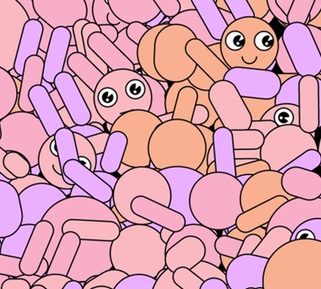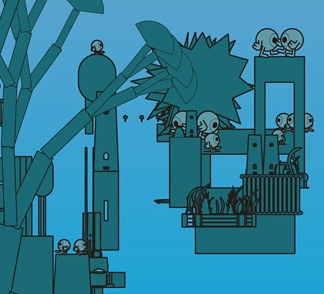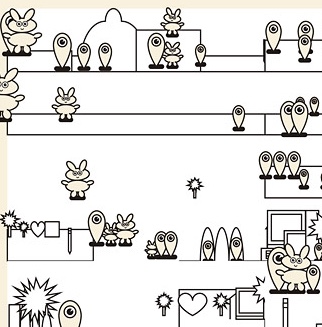
I stumbled across this amazing Tumblr the other day, by a guy named John Pound. He’s been making code-based (i.e., algorithmic, or generative) art for over twenty (20!) years, most of that time in PostScript for print, but more recently including screen-based art and animation done with JavaScript.
Pound says his algorithmic work started with the premise of, “What would a computer-generated comic strip look like?” and since then has evolved his code and produced a mountain of output. As with (IMHO) almost all generative art, taste and selectivity play an important role in choosing which works get published. Curiously, though, apart from the Tumblr, not much of his work has seen an audience.
Many small figures and objects (functions, really) are composed into complete compositions, with almost every aspect determined by constrained randomness.
He compiles selections of output into “sketchbooks,” which are actually print-on-demand realizations limited to a run of one copy, which he keeps for himself. He has plans to put together a “best-of” compilation in a more widely available edition.

There is some amazing stuff in the Cartooning Code archives:
- One that’s just a series of generated rooms.
- Complete generated comic strips (even the text is generated, and designed to be self-referential).
- Whole matrices of miniature scenes that look like the storyboard of a surrealist film.
- The first piece of generative art that made me laugh: Couples.
- Rolling heads and Wheels of Time!
- Amazing panoramas
There’s even a music video he made, in collaboration with coding musician Jace Ewing, that is a delightful party of playful characters, comical rolling objects, and parallax effects: The WaterClock

Interestingly, in the midst of all this randomness, it’s the consistent elements that really make the work special. The cartoony figures with limbs all askew. The Eyewizzes. The sheer multiplicity. Together they hint at a pattern language, a personal mythos, that is the engine of all this wonderful creativity.
Sources.
- Random Comics Drawn with Code, Since the 80's - Weiner, Sophie. animalnewyork.com, 2014-08-13.
- The Guy Behind Garbage Pail Kids Has Been Cartooning with Code for 20 Years - VanHemert, Kyle. wired.com, 2014-08-12.